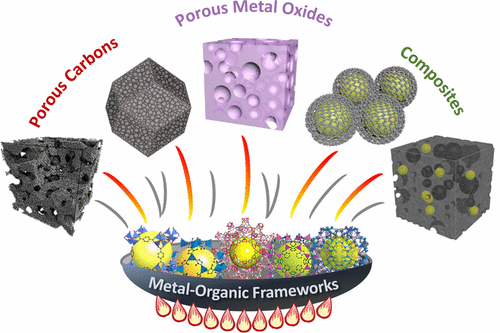当前位置:
X-MOL 学术
›
Acc. Chem. Res.
›
论文详情
Our official English website, www.x-mol.net, welcomes your
feedback! (Note: you will need to create a separate account there.)
Transformation of Metal–Organic Frameworks/Coordination Polymers into Functional Nanostructured Materials: Experimental Approaches Based on Mechanistic Insights
Accounts of Chemical Research ( IF 16.4 ) Pub Date : 2017-10-09 00:00:00 , DOI: 10.1021/acs.accounts.7b00259 Kyung Joo Lee 1 , Jae Hwa Lee 1 , Sungeun Jeoung 1 , Hoi Ri Moon 1
Accounts of Chemical Research ( IF 16.4 ) Pub Date : 2017-10-09 00:00:00 , DOI: 10.1021/acs.accounts.7b00259 Kyung Joo Lee 1 , Jae Hwa Lee 1 , Sungeun Jeoung 1 , Hoi Ri Moon 1
Affiliation

|
Nanostructured materials such as porous metal oxides, metal nanoparticles, porous carbons, and their composites have been intensively studied due to their applications, including energy conversion and storage devices, catalysis, and gas storage. Appropriate precursors and synthetic methods are chosen for synthesizing the target materials. About a decade ago, metal–organic frameworks (MOFs) and coordination polymers (CPs) emerged as new precursors for these nanomaterials because they contain both organic and inorganic species that can play parallel roles as both a template and a precursor under given circumstances. Thermal conversions of MOFs offer a promising toolbox for synthesizing functional nanomaterials that are difficult to obtain using conventional methods. Although understanding the conversion mechanism is important for designing MOF precursors for the synthesis of nanomaterials with desired physicochemical properties, comprehensive discussions revealing the transformation mechanism remain insufficient.
中文翻译:

金属有机骨架/配位聚合物向功能纳米结构材料的转化:基于机理的实验方法
纳米结构材料,例如多孔金属氧化物,金属纳米颗粒,多孔碳及其复合材料,由于其应用广泛研究,包括能量转换和存储设备,催化和气体存储。选择合适的前体和合成方法来合成目标物质。大约十年前,金属有机骨架(MOF)和配位聚合物(CP)成为这些纳米材料的新前体,因为它们既包含有机物又包含无机物,在给定的情况下,它们既可以充当模板,也可以充当前体。MOF的热转化为合成功能纳米材料提供了有前途的工具箱,而这些功能纳米材料是使用传统方法难以获得的。
更新日期:2017-10-09
中文翻译:

金属有机骨架/配位聚合物向功能纳米结构材料的转化:基于机理的实验方法
纳米结构材料,例如多孔金属氧化物,金属纳米颗粒,多孔碳及其复合材料,由于其应用广泛研究,包括能量转换和存储设备,催化和气体存储。选择合适的前体和合成方法来合成目标物质。大约十年前,金属有机骨架(MOF)和配位聚合物(CP)成为这些纳米材料的新前体,因为它们既包含有机物又包含无机物,在给定的情况下,它们既可以充当模板,也可以充当前体。MOF的热转化为合成功能纳米材料提供了有前途的工具箱,而这些功能纳米材料是使用传统方法难以获得的。











































 京公网安备 11010802027423号
京公网安备 11010802027423号